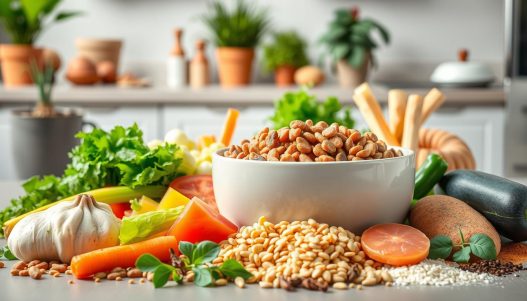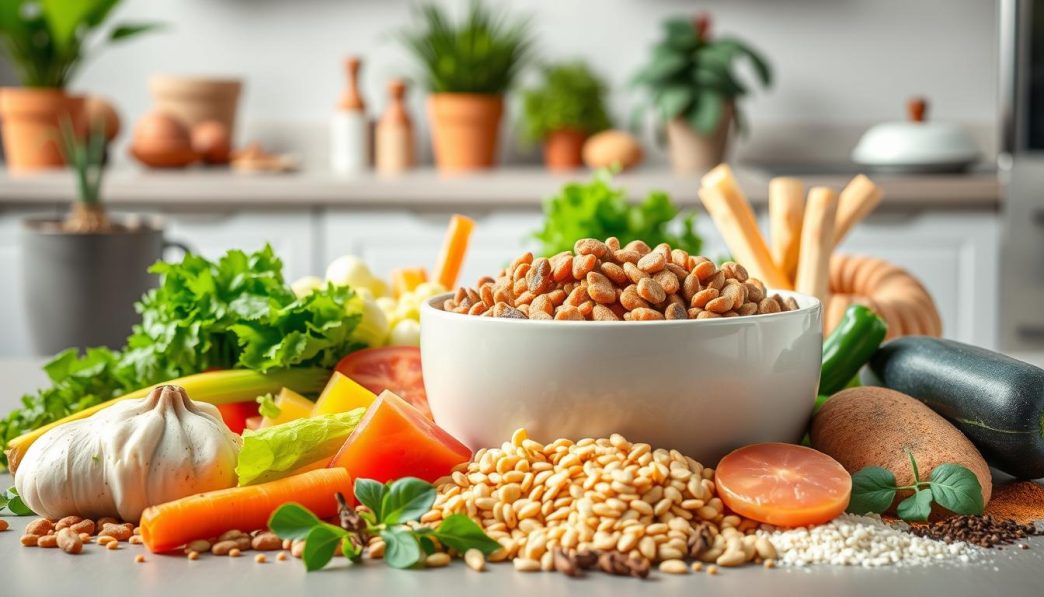It’s very important to give your pet a balanced diet. This helps them stay healthy and happy. A well-fed pet is more likely to live a long and joyful life.
A balanced diet gives your pet all the nutrients they need. This includes proteins, carbs, fats, vitamins, and minerals. Knowing what your pet needs is key to keeping them healthy.
Key Takeaways
- A balanced diet is essential for maintaining pet health.
- Understanding nutritional needs is crucial for a healthy pet.
- Essential nutrients include proteins, carbohydrates, fats, vitamins, and minerals.
- A well-nourished pet is more likely to lead a happy and healthy life.
- A balanced diet directly impacts your pet’s overall wellbeing.
Understanding Your Pet’s Nutritional Needs
Every pet has special nutritional needs to stay healthy. It’s important to give them the right mix of nutrients. This helps keep them well and prevents health problems.
Species-Specific Requirements: Dogs vs. Cats
Dogs and cats need different foods because of their unique bodies. Cats need lots of protein from meat because they are obligate carnivores. Dogs, being omnivores, can eat a variety of foods. Knowing what each needs is key to picking the right food.
Age and Life Stage Considerations
Puppies and kittens need more protein and calories for growth. Adult pets need less to avoid getting too fat. Changing their diet based on their age is important for their health.
Health Status and Special Needs
Pets with health issues or special needs need special diets. For example, pets with food allergies must avoid certain foods. Always talk to a vet to find the best diet for them.
“A well-balanced diet is not just about providing energy; it’s about supporting overall health and preventing disease.”
Essential Nutrients for Optimal Pet Health
A balanced diet is key for pets to stay healthy. They need different nutrients for energy, growth, and repair.
Proteins: The Building Blocks
Proteins are vital for pets. They help with growth, repair, and keeping tissues healthy. Good protein sources are chicken, salmon, and lamb. These help with skin, coat, and muscle health.
Fats: Energy and Cellular Function
Fats are important for pets. They give energy and help cells work right. Omega-3 and omega-6 fatty acids are especially good. They help with skin, coat, and reduce inflammation.
Carbohydrates: Energy Sources
Carbohydrates are a main energy source for pets. Good sources are whole grains, fruits, and veggies. They also help with digestion.
Vitamins and Minerals: Micronutrient Importance
Vitamins and minerals are crucial for pets. They support many functions, like bone health and the immune system. Important ones include vitamin D and E, and minerals like calcium and phosphorus.
| Nutrient | Function | Sources |
|---|---|---|
| Proteins | Growth, maintenance, repair | Chicken, salmon, lamb |
| Fats | Energy, cellular function | Omega-3 and omega-6 fatty acids |
| Carbohydrates | Energy | Whole grains, fruits, vegetables |
| Vitamins and Minerals | Bodily functions, bone health, immune function | Vitamin D, E, calcium, phosphorus |
Commercial Pet Foods: Making Informed Choices
Choosing the right commercial pet food is important. It’s key to know the different types and their benefits. This helps you make a smart choice for your pet.
Decoding Pet Food Labels and Ingredients
Pet food labels can be tricky to read. But, it’s vital to understand them. Look for the ingredient list and the nutritional statement.
Ingredients are listed by weight. So, the first ones are the most important. A high-quality protein source should be at the top. Avoid fillers and by-products as they don’t offer much nutrition.
Dry vs. Wet Food Options
Dry and wet foods have their own perks. Dry food is easy to use and good for teeth. Wet food tastes better and has more moisture.
Some pets do well with a mix of both. This keeps them happy and hydrated. Think about your pet’s likes, lifestyle, and needs when choosing.
Quality Indicators in Manufactured Foods
When picking commercial pet food, look for quality signs. Check if it meets AAFCO (Association of American Feed Control Officials) standards. These ensure the food is nutritious.
Also, check the maker’s reputation and quality checks. You can find this info on their website or by calling customer service.
Homemade and Raw Diets: Benefits and Risks
Many pet owners are choosing homemade and raw diets for their pets. They want a more natural way to feed them. But, these diets have risks that need careful attention.

Properly Balancing Homemade Meals
Making a balanced homemade diet is key. You need to know what your pet needs. This includes proteins, fats, carbohydrates, vitamins, and minerals in the right amounts.
If your pet doesn’t get these, they might get sick. This could weaken their immune system or make their coat look bad.
- Consult with a veterinary nutritionist to formulate a balanced recipe.
- Use a variety of ingredients to ensure a broad spectrum of nutrients.
- Regularly monitor your pet’s health and adjust the diet as needed.
Raw Diet Safety Considerations
Raw diets can be risky because of bacterial contamination. This includes Salmonella or E. coli. It’s important to handle raw ingredients safely.
- Freeze raw meat to kill parasites before feeding.
- Wash hands and surfaces thoroughly after handling raw ingredients.
- Store raw ingredients separately to prevent cross-contamination.
Consulting with Veterinary Nutritionists
For a safe and balanced diet, talk to a veterinary nutritionist. They can make a diet that fits your pet’s needs.
With careful planning, homemade and raw diets can be good for your pet. They can get the nutrients they need for a healthy life.
Pet Nutrition Tips for a Balanced Diet
A well-balanced diet is key to your pet’s health. There are important factors to keep in mind. By following some simple pet nutrition tips, you can greatly improve your pet’s health and happiness.
Portion Control and Feeding Schedules
It’s important to control how much food your pet eats. Eating too much can lead to obesity, while not enough can cause malnutrition. A consistent feeding schedule helps keep your pet’s appetite and metabolism in check. Always follow the feeding guidelines from the pet food manufacturer and adjust as needed for your pet.
Transitioning Between Foods Safely
Changing your pet’s food should be done slowly to avoid upset stomachs. Begin by mixing a little of the new food with their old food. Gradually increase the new food over 7-10 days. This gradual transition helps your pet’s stomach get used to the new food.
Monitoring Body Condition and Weight
It’s important to regularly check your pet’s body condition and weight. They should have a visible waistline and you should be able to feel their ribs without too much fat. Use a weight chart or talk to your vet to find out your pet’s ideal weight.
| Pet Condition | Ideal | Overweight |
|---|---|---|
| Ribs Visibility | Easily felt | Difficult to feel |
| Waistline | Visible | Not visible |
| Weight Status | At ideal weight | Above ideal weight |
By following these pet nutrition tips, you can help keep your pet’s diet balanced and healthy. Always consult with your vet for advice that fits your pet’s unique needs.
Hydration: An Essential Component of Pet Nutrition
Hydration is key in pet care but often ignored. It’s important to make sure your pet always has fresh water. Knowing their hydration needs is vital for their health.
Water Requirements for Different Pets
Pets need different amounts of water based on their type, size, age, and how active they are. Dogs usually need more water than cats. Also, pets that are more active need more water than those that are not.
Average Water Intake:
| Pet Type | Average Water Intake (ml/kg/day) |
|---|---|
| Dogs | 50-60 |
| Cats | 30-40 |
Encouraging Proper Hydration
To get your pet to drink more water, keep their water bowl clean and full. Some pets like running water, so a water fountain can help them drink more.
Tips for Encouraging Hydration:
- Change water often to keep it fresh
- Use a water fountain to attract pets to drink more
- Place multiple water sources around the house
Wet Food and Hydration Balance
Adding wet food to your pet’s diet can help with hydration. Wet food has more moisture than dry food, which is good for keeping your pet hydrated.
Benefits of Wet Food for Hydration:
- Higher moisture content
- Can be more palatable for pets
- Helps in maintaining urinary health
Common Nutritional Problems in Pets
Many pets face nutritional challenges that can harm their health. It’s important to understand these issues to care for them well.
Obesity: Causes, Risks, and Management
Obesity in pets is a big problem, often due to too much food and not enough exercise. It can lead to diabetes, arthritis, and heart disease. Managing obesity means a balanced diet and regular exercise.
Food Allergies and Sensitivities
Food allergies and sensitivities can cause skin and digestive issues in pets. It’s crucial to avoid foods that cause problems. Consulting with a veterinarian helps find the right solution.
Nutritional Deficiencies and Excesses
Nutritional problems can cause serious health issues. Lack of nutrients can lead to developmental problems, while too much can be toxic. Balancing nutrients is essential for good health.
Knowing about these nutritional problems and acting early can greatly improve pets’ health and happiness.
Supplements: When They’re Necessary
While a balanced diet is key, supplements can offer extra support for pets with special needs. They are not a substitute for a healthy diet. But, they can help with certain health issues.
Joint Supplements for Aging Pets
As pets get older, their joints need more care. Supplements with glucosamine and chondroitin can ease arthritis symptoms and boost mobility. They help keep the cartilage and joints healthy, reducing pain and improving life quality for older pets.

Omega Fatty Acids and Skin Health
Omega fatty acids, like omega-3 and omega-6, are vital for healthy skin and a shiny coat. They fight inflammation and can help with skin problems like allergies and dermatitis. Adding omega fatty acid supplements to your pet’s diet can greatly improve their skin health and look.
Probiotics for Digestive Health
Probiotics are good bacteria that keep the gut healthy. They help with digestive issues like diarrhea, constipation, and irritable bowel syndrome. By keeping the gut flora balanced, probiotics boost overall health, improve nutrient absorption, and strengthen the immune system.
| Supplement Type | Health Benefit | Common Ingredients |
|---|---|---|
| Joint Supplements | Supports joint health, alleviates arthritis symptoms | Glucosamine, Chondroitin |
| Omega Fatty Acids | Improves skin health, reduces inflammation | Omega-3, Omega-6 |
| Probiotics | Supports digestive health, boosts immune system | Lactobacillus, Bifidobacterium |
Always talk to a vet before adding supplements to your pet’s diet. This ensures they are needed and safe, especially if your pet has other health issues or takes medications.
Breed-Specific and Size-Based Nutritional Considerations
Choosing the right food for your pet can greatly improve their health and happiness. Different pets have unique nutritional needs. These needs are key to their well-being.
Large vs. Small Breed Requirements
Large dogs, like Great Danes, need more calories and certain nutrients. This helps them grow and keeps their joints healthy. Small dogs, such as Chihuahuas, need more energy because they have a fast metabolism.
Breed-Related Health Conditions and Diet
Some breeds face health issues that can be helped by their diet. For instance, Bulldogs often get fat and have skin problems. A diet full of omega fatty acids and with controlled calories can help.
Specialized Formulas for Specific Breeds
Some pet foods are made just for certain breeds. These formulas tackle breed-specific health issues. They ensure your pet gets the best nutrition.
Experts say, “Knowing your pet’s nutritional needs is vital for the right diet.” The right food can greatly improve your pet’s life.
Conclusion: Creating a Lifelong Nutrition Plan
Creating a lifelong nutrition plan for your pet means knowing their special needs. It’s about picking the right food and watching out for things like staying hydrated and supplements. A balanced diet is key to keeping your pet healthy and happy.
Think about your pet’s age, health, and life stage when choosing their diet. You might choose commercial pet foods or homemade meals. But, make sure they get all the nutrients they need. Talking to a vet can help you create a diet plan that fits your pet’s needs perfectly.
A lifelong nutrition plan is an ongoing journey, not just a one-time choice. Regular vet visits and keeping an eye on your pet’s health are important. This way, you can make changes as needed to keep your pet healthy and happy for life.






